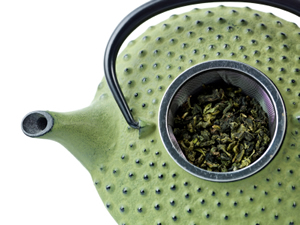Oolong Tea Camellia sinensis

Oolong tea in Japanese teapot
- Common Names
- Oolong Tea , Wu Long, Wu Yi Tea
- Botanical Name
- Camellia sinensis
- Family
Medicinal Uses & Benefits of Oolong Tea
![]() How to Use|
Side Effects |
Plant & Garden|
How to Use|
Side Effects |
Plant & Garden|
- Medicinal Uses: * Chinese
* Chinese
* Culinary/Kitchen
* Diet/weight Loss
- Properties: * Antioxidant * Appetite Depressant * Astringent * Diuretic * Stimulant
- Parts Used: leaves
- Constituents: amino acid l-theanine, caffeine, catechin polyphenols, epigallocatechin gallate (egcg),oxalates, fluoride,tannin
How to Use: Oolong Tea
Oolong tea is unique because of its partial fermentation which produces a diverse arrangement of both off-green and black leaves. This tea is beautiful, tasty, full bodied, healthy and with a mildly smooth aftertaste. The tea has become more popular in the West, marketed mainly as a diet aid, but just like green tea and all the different varieties of Camellia sinensis, oolong tea is rich in antioxidants that can help prevent cancer and heart disease and contribute to well-being. The health benefits add an extra layer of goodness to the simple enjoyment of the unique full bodied taste of oolong teas.
So what is the current craze with Wu Long slimming tea about? Claims like "World's Most Powerful Fat Burner - Melt Away Your Fat, Skyrocket Your Energy, and Cut The Effects Of Carbs!", are speeding around the internet at the speed of light. It is true that Oolong/Wu Long tea not only boosts metabolism and suppresses sugar cravings, but it may also burn fat, making this tea a good addition to any healthy diet plan. However claims that you need to purchase special brands of Wu long tea to get these benefits should be met with a healthy dose of skepticism. The main difference that I can see between Wu long and Oolong tea is the exorbitant price you pay for teas branded as Wu long.
Preparation Methods & Dosage :Because of the caffeine content, green tea should be prepared using small amounts of herb and steeped no longer than 1-2 minutes
Oolong Tea Remedies
Traditional Chinese Medicine
 Oolong tea was first produced in the Wuyi Mountains at the beginning of the Qing Dynasty.
Oolong (also spelt Wulong, or Wu Long) is literally 'black dragon' tea, but they say the name originally had nothing to do with dragons; rather, it was named after its discoverer Wu Liang.
Oolong tea was first produced in the Wuyi Mountains at the beginning of the Qing Dynasty.
Oolong (also spelt Wulong, or Wu Long) is literally 'black dragon' tea, but they say the name originally had nothing to do with dragons; rather, it was named after its discoverer Wu Liang.
Oolong Tea Side Effects: Overuse of caffeine can affect sleep. However,the decaffeination process reduces the total catechins in both black and green dry teas teas. Moderation is key.
Plant Description

Koehler's Medicinal-Plants
- Oolong tea comes from the same plant (Camellia sinensis) as green and black tea, the difference is in the fermentation and drying processes.
- Oolong Tea leaves are picked on the morning of a clear day in units consisting of one bud and three leaves and exposed to the sun.
- The second stage is to dry them indoors to promote fermentation. The most crucial part in the production of oolong tea is when to stop fermentation, which is when the leaves are 30% red and 70% green. After this, they are rubbed repeatedly to generate good flavor, aroma, and texture and are dried using charcoal.
- At the final stage, a tea master grades the quality according to the flavor and characteristics of each batch.
Regional Traditions :Traditional Chinese Medicine *











